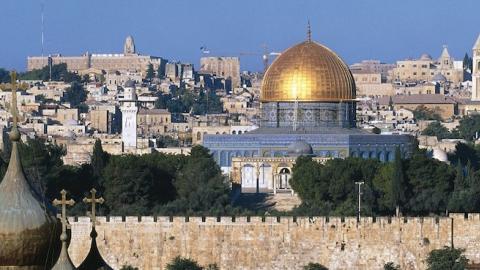Just north of Jerusalem, along the traditional invasion route into the Old City, the remnants of an ancient Crusader fortress stands on one of the highest of Jerusalem’s many craggy hills. In an underground chamber deep within the complex’s stone walls, rests the tomb of the Prophet Samuel—a revered pilgrimage destination for Jews. An eighteenth century mosque abuts the tomb, its minaret rising into the sky. The site is quintessentially Holy Land—layers of Christian, Jewish, and Muslim tradition all stack upon one another. It is only when one reaches the rooftop, however, that a fourth, uniquely American, religion comes into view: the Israeli-Palestinian peace process.
Looking south from the rooftop, one can almost touch the Jewish ring neighborhood of Ramot, organically linked to Jerusalem yet north of the 1967 armistice line. Pivoting north for a view of Ramallah, a series of Israeli settlements pocket the landscape. For decades, American officials have attributed mythical powers to these settlements, transforming their dissolution into the Holy Grail of international politics. Israeli concessions to the Palestinians, so the thinking has gone, would breathe life into America’s relationship with the Arab world. Looking out over Jerusalem and the West Bank last month, however, the link between local conflict and regional order was not clear to me at all. In fact, with President Obama reportedly weighing resurrecting the peace process, a push to resolve the conflict by setting down markers appears downright foolish.
For most Americans national security professionals, the Israeli-Palestinian peace process goes by another name—the Middle East peace process. For example, already on his second full day in office, President Obama appointed former Senator George Mitchell to the post of special envoy for Middle East Peace—a telling insight into Obama’s thinking and priorities. Five months later, during a major speech in Cairo, Obama explained the logic, identifying the Israeli-Palestinian conflict as perhaps the “major source of tension” in the Arab world. Clearly, the president saw solving the conflict as an urgent national security priority for the region as a whole.
As the intervening years have shown, however, the Israeli-Palestinian dispute sits at the margins of what truly matters in the Middle East. The region is not driven by any ideational commitment to Palestinian liberation, but by local power politics operating in an acute security setting. From George Mitchell to John Kerry, American peacemakers have come and gone, often stumbling badly along the way. Turkish and Arab leaders, busily competing amongst themselves and against Iran, appear to have barely noticed. It is hard to fault them for their disinterest. After all, even the Palestinian are bitterly divided, locked in an enduring battle for power between Fatah and Hamas, which controls Gaza. Moreover, even if an Israeli-Palestinian agreement were to miraculously materialize, it would not improve America’s position on any issue of consequence. Indeed, the Israeli-Palestinian dispute remains irrelevant to what our own Turkish and Arab allies across the region desire most—an American-led coalition dedicated to rolling back Iran.
On a clear day from the roof of the Prophet Samuel’s tomb, one can also see the skyscrapers of Tel Aviv to the northwest and the mountains of Jordan in the east. Geographic size alone, then, ensures that Israel will remain a perpetually insecure ally, even during the best of times. And today is hardly the best of times. America’s withdrawal from the region has invited Russia and Iran to take its place. From Jerusalem, Israeli leaders warily eye Iranian Revolutionary Guard Corps troops as they rampage across western and northern Syria. Depending upon the outcome of the Russian-Iranian offensive in Syria, Israel faces a first-order strategic threat potentially directly on its border. How is Obama responding to this danger to his ally? By considering where he might set down markers on the Israeli-Palestinian question.
The region is rapidly deteriorating; Israel is awash in terrorist stabbings; the Palestinian leadership is divided; Gaza is run by Hamas; and, Israelis have just endorsed Prime Minister Netanyahu’s call for strategic patience in national elections. In other words, no one is in the mood for more peacemaking. Yet Obama presses on, intent to set down the parameters for an agreement, partners be damned. What explains this disconnect?
In January 2014, during one bout of American peacemaking, Israeli Defense Minister Moshe Yaalon spoke of the “messianic fervor” of Secretary Kerry’s Israel-Palestinian diplomacy before adding, “The only thing that can ‘save us’ is for John Kerry to win a Nobel Prize and leave us in peace.” Yaalon’s comment was undiplomatic, but his appreciation for American domestic politics was highly sophisticated. President Obama’s insistence on reengaging the peace process says far more about American domestic politics, especially in the eighth year of a presidency, than Middle Eastern realities.
In the first Book of Samuel, the Philistines return the Ark of the Covenant to Israel after capturing it in battle, leading the Prophet Samuel to instruct the house of Israel to set aside the distraction of false gods if they are to escape further harm. Thousands of years later, President Obama would be wise to take Samuel’s counsel and avoid the false god of Legacy. Past administrations have succumbed to the temptation of a late push for Israeli-Palestinian peace, only to leave office disillusioned and the region picking up the pieces.


















